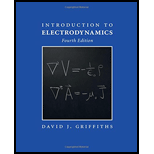
Introduction to Electrodynamics
4th Edition
ISBN: 9781108420419
Author: David J. Griffiths
Publisher: Cambridge University Press
expand_more
expand_more
format_list_bulleted
Question
Chapter 1.2, Problem 1.20P
To determine
A vector function for which curl and divergence both are zero.
Expert Solution & Answer
Want to see the full answer?
Check out a sample textbook solution
Students have asked these similar questions
Show that if A and B are matrices which don’t commute, then eA+B = eAeB, but if they do commute then the relation holds. Hint: Write out several terms of the infinite series for eA, eB, and eA+B and do the multiplications carefully assuming that A and B don’t commute. Then see what happens if they do commute.
Let f(x)= 4xex - sin(5x). Find the third derivative of this function.
Note ex is denoted as e^x below.
Select one:
(12+4x^3)e^x + 125sin(5x)
12e^x + 125cos(5x)
not in the list
(12+4x)e^x + 125cos(5x)
(8+4x)e^x + 25sin(5x)
Evaluate the commutator [Â,B̂] of the following operators.
Chapter 1 Solutions
Introduction to Electrodynamics
Ch. 1.1 - Using the definitions in Eqs. 1.1 and 1.4, and...Ch. 1.1 - Prob. 1.2PCh. 1.1 - Prob. 1.3PCh. 1.1 - Prob. 1.4PCh. 1.1 - Prob. 1.5PCh. 1.1 - Prob. 1.6PCh. 1.1 - Prob. 1.7PCh. 1.1 - Prob. 1.8PCh. 1.1 - Prob. 1.9PCh. 1.1 - Prob. 1.10P
Ch. 1.2 - Prob. 1.11PCh. 1.2 - The height of a certain hill (in feet) is given by...Ch. 1.2 - Prob. 1.13PCh. 1.2 - Prob. 1.14PCh. 1.2 - Prob. 1.15PCh. 1.2 - Prob. 1.16PCh. 1.2 - Prob. 1.17PCh. 1.2 - Prob. 1.18PCh. 1.2 - Prob. 1.19PCh. 1.2 - Prob. 1.20PCh. 1.2 - Prob. 1.21PCh. 1.2 - Prob. 1.22PCh. 1.2 - Prob. 1.23PCh. 1.2 - Prob. 1.24PCh. 1.2 - Prob. 1.25PCh. 1.2 - Prob. 1.26PCh. 1.2 - Prob. 1.27PCh. 1.2 - Prob. 1.28PCh. 1.3 - Prob. 1.29PCh. 1.3 - Prob. 1.30PCh. 1.3 - Prob. 1.31PCh. 1.3 - Prob. 1.32PCh. 1.3 - Prob. 1.33PCh. 1.3 - Prob. 1.34PCh. 1.3 - Prob. 1.35PCh. 1.3 - Prob. 1.36PCh. 1.4 - Prob. 1.37PCh. 1.4 - Express the unit vectors in terms of (that is,...Ch. 1.4 - Prob. 1.39PCh. 1.4 - Prob. 1.40PCh. 1.4 - Prob. 1.41PCh. 1.4 - Prob. 1.42PCh. 1.4 - Prob. 1.43PCh. 1.5 - Evaluate the following integrals:
(a)
(b)
(c)...Ch. 1.5 - Prob. 1.45PCh. 1.5 - (a) Show that .
[Hint: Use integration by...Ch. 1.5 - Prob. 1.47PCh. 1.5 - Prob. 1.48PCh. 1.5 - Prob. 1.49PCh. 1.6 - (a) Let and . Calculate the divergence and curl...Ch. 1.6 - Prob. 1.51PCh. 1.6 - Prob. 1.52PCh. 1.6 - Prob. 1.53PCh. 1.6 - Prob. 1.54PCh. 1.6 - Prob. 1.55PCh. 1.6 - Prob. 1.56PCh. 1.6 - Prob. 1.57PCh. 1.6 - Prob. 1.58PCh. 1.6 - Prob. 1.59PCh. 1.6 - Prob. 1.60PCh. 1.6 - Prob. 1.61PCh. 1.6 - Prob. 1.62PCh. 1.6 - Prob. 1.63PCh. 1.6 - Prob. 1.64P
Knowledge Booster
Similar questions
- In Poincare transformation if scalar field is invariant under translation, then prove that generator of translation is momentum 4 vector.arrow_forwardI have been able to do this with derivatives but I can't figure out how to do this with definite integralsarrow_forwardFind the Miller Indices of a plane whose intercepts are (2,1,3).arrow_forward
- Two mass points of mass m1 and m2 are connected by a string passing through a hole in a smooth table so that m1 rests on the table surface and m2 hangs suspended. Assuming m2 moves only in a vertical line, what are the generalized coordinates for the system? Write the Lagrange equations for for the system and, if possible, discuss the physical significance any of them might have. Reduce the problem to a single second-order differential equation and obtain a first integral of the equation. What is its physical significance? (Consider the motion only until m1 reaches the hole.)arrow_forwardIf we have two operators A and B possess the same common Eigen function, then prove that the two operators commute with each otherarrow_forwardWhat is the value of α so that the resultant of the three forces is to bevertical?arrow_forward
- Show that the operator H = -1/2(d^2/dx^2) is hermitian, assuming that it operates on a Hilbert space of L^2 functions whose functions and derivatives vanish at x = −∞ and x = +∞arrow_forwardProve the Jacobi identity: A × (B × C) + B × (C × A) + C × (A × B) = 0. Hint:Expand each triple product as in equations (3.8) and (3.9).arrow_forwardVerify that vp=2kBTm.`arrow_forward
arrow_back_ios
arrow_forward_ios
Recommended textbooks for you
 Classical Dynamics of Particles and SystemsPhysicsISBN:9780534408961Author:Stephen T. Thornton, Jerry B. MarionPublisher:Cengage Learning
Classical Dynamics of Particles and SystemsPhysicsISBN:9780534408961Author:Stephen T. Thornton, Jerry B. MarionPublisher:Cengage Learning

Classical Dynamics of Particles and Systems
Physics
ISBN:9780534408961
Author:Stephen T. Thornton, Jerry B. Marion
Publisher:Cengage Learning
